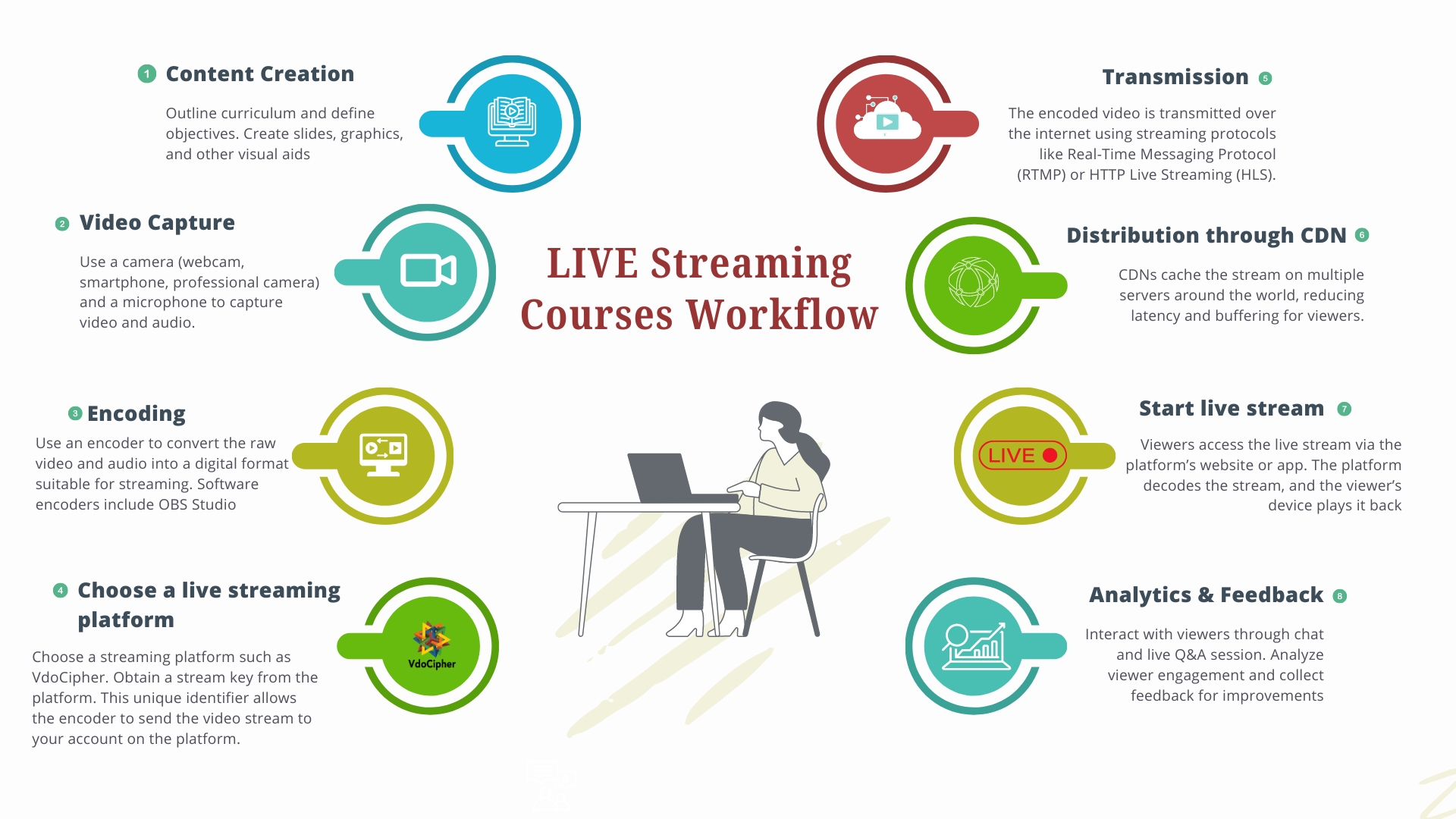The COVID-19 global pandemic and the social distancing policies have significantly transformed the educational landscape, shifting from traditional in-person learning to a fully online distance learning model. This shift has led to the emergence of new educational paradigms. As billions of students transition to studying from home & live online courses, educators are leveraging various technologies to maintain the continuity and quality of education. This directive affected over 200 million students and 20 million instructors, necessitating a swift adaptation to new methods of HD live stream teaching and learning.
“The global e-learning market, including online live learning, was valued at $315 billion in 2021 and is projected to reach $1 trillion by 2028, growing at a compound annual growth rate (CAGR) of 20% from 2022 to 2028.”
Central to this transformation is the widespread adoption of live streaming courses/classes, where educators connect with students via real-time communication tools such as Zoom and other live streaming platforms like VdoCipher. This method allows for live lectures, interactive sessions, HD live stream and real-time collaboration among students and instructors through software interfaces.
Table of Contents:
- Why is online live learning the need of the hour?
- HD live stream in online learning
- HD vs. SD live streaming
- Technical requirements for HD live stream
- Creating a successful live streaming course
- Essential equipment and software for HD live streaming
- Tips for engaging live online lessons
- How VdoCipher enhances HD live streaming
- FAQs
Traditional classroom settings involve synchronous, co-located interactions, where all interactions between teachers and students occur in the same physical space. Massive Open Online Courses (MOOCs) represent a distant asynchronous interaction mode, where learners engage with pre-recorded content and interact with instructors asynchronously. In contrast,online live learning represents a distant synchronous mode, where real-time interaction occurs despite physical separation.
Why is online live learning the need of the hour?
The sudden influx of users to online platforms posed significant challenges. Existing issues in online education, such as promoting student engagement, became more pronounced. Additionally, the shift highlighted inequalities in education due to disparities in teachers’ technical skills, students’ access to the internet, and varying levels of school support.
For many students, particularly in low-income and diverse school districts, lack of internet access hindered their ability to participate in online classes. Teachers, on the other hand, faced the demanding task of developing online courses, which typically requires extensive preparation and hundreds of hours of work.
Live online courses emerged as a crucial tool to address these challenges. Mobile devices, which are more widespread than personal laptops, facilitated the adoption of LVS. Live Streaming has already become a popular form of social interaction, with millions of users engaging in it daily. This familiarity with livestreaming made it a natural choice for schools and teachers to broadcast their classes online.
“Corporate e-learning, which often includes live learning components, is expected to grow by 13% annually. Organizations increasingly rely on live online training to reskill and upskill employees.”
While live streaming classes have been studied in various contexts such as gaming, e-commerce, and civic engagement, its use in formal education across all levels during a crisis is less explored. The pandemic forced a unique situation where both teachers and students had to adapt quickly to online education without the option of face-to-face interaction. This transition highlighted the need for effective online teaching methods and the potential of live online classes to support education during unprecedented times.
By online live learning, educational institutions could overcome some of the time constraints and resource limitations that traditional online course development entails. This live online courses approach provided a flexible and immediate solution to continue education amidst the global pandemic.
Zenstream live can help you stream your content live to your users. You can also engage with your audience with the chat feature.
HD live stream in online learning
HD, or “high definition,” refers to video streaming with resolutions typically ranging from 720p to 1080p. This higher resolution results in a much clearer and crisper image compared to standard definition (SD). With advancements in technologies like Google cloud video streaming, HD has become the industry standard, providing superior video quality for a wide range of applications, from entertainment to education. HD live streaming is the optimal choice for broadcasters aiming to deliver top-notch video quality. While it requires more bandwidth and a reliable internet connection, the investment in high-quality content is worthwhile.
“80% of consumers now prefer watching live video to reading a blog, and 82% prefer live video from a brand to social posts.”
The resolution of HD streaming is significantly higher than SD, leading to better video quality. More pixels in an image mean sharper and more detailed visuals, enhancing the viewing experience. This is crucial whether you are streaming revenue-generating content or aiming to grow your audience, as the quality of your stream directly reflects on your brand.
HD vs. SD live streaming
When deciding between SD vs HD streaming, it’s essential to understand the benefits and drawbacks of each:
- Video Quality: HD streaming offers higher resolution, making the image clearer and more detailed than SD.
- Bandwidth Usage: HD streaming consumes more bandwidth due to the higher bitrate required. This means it demands a faster and more reliable internet connection.
- Viewer Experience: As more viewers have access to high-speed internet, they can support HD streaming, which is increasingly becoming the preferred option.
| Aspect | SD (Standard Definition) | HD (High Definition) |
| Resolution | 480p (640×480 pixels) or 576p (720×576 pixels) | 720p (1280×720 pixels) or 1080p (1920×1080 pixels) |
| Image Quality | Basic quality, suitable for smaller screens | Clearer and more detailed, ideal for larger screens |
| Bandwidth Requirements | 1-3 Mbps | 5-10 Mbps (720p) or 10-20 Mbps (1080p) |
| Internet Speed | Suitable for slower internet connections | Requires stable and faster internet connections |
| Viewer Experience | Adequate for mobile devices and older TVs | Superior experience with crisper images and better detail |
| Latency | Lower latency due to smaller data size | Potentially higher latency due to larger data size |
| Encoding and Decoding | Easier to encode and decode, less processing power | Requires advanced encoding and decoding, more processing power |
| Typical Use Cases | Video conferencing, low-bandwidth areas | Professional live broadcasts, high-speed internet audiences |
| Data Consumption | Lower data usage, cost-effective | Higher data usage, potentially more expensive |
| Infrastructure Needs | Lower, less powerful servers and network resources | Higher, robust servers and network resources needed |
Technical requirements for HD live stream
To ensure a high-quality HD stream, several factors need to be considered:
Reliable Internet Connection – The upload speed of your internet connection should be at least double the bandwidth you intend to use for streaming. Here are some general guidelines:
- 25 Mbps: Sufficient for streaming 1080p HD video.
- 10 Mbps: Sufficient for streaming 720p video.
- 5 Mbps: Sufficient for streaming 480p video.
Use tools like Google’s speed test to check your internet speed and ensure it meets the requirements.
Proper Equipment – Ensure your streaming setup includes a reliable camera and a compatible online video player that supports HD streaming. Most modern video players, like VdoCipher, are equipped to handle HD or even higher quality streaming.
Encoder Settings – Properly configure your encoder’s bitrate and resolution settings to match the desired quality of your stream. This step is crucial to maintaining the high-definition quality throughout the broadcast.
Creating a successful live streaming course
Creating a successful live-streaming course involves meticulous planning, technical proficiency, and strategies to engage and retain your audience. Here’s a detailed guide to help you create an impactful and professional live-streaming course.
Identify Your Audience and Objectives
- Audience Analysis: Conduct surveys or interviews to understand your target audience’s demographics, learning preferences, and knowledge level.
- Learning Objectives: Use Bloom’s Taxonomy to define clear, measurable learning outcomes. For instance, “By the end of this course, students will be able to apply X technique in Y context.”
“HD live streaming is being widely adopted for webinars, conferences, and virtual events, with the corporate segment expected to grow at a CAGR of 30% through 2027.”
Course Outline
- Module Breakdown: Divide your course into coherent modules. Each module should address a specific topic or skill.
- Lesson Planning: Draft a detailed lesson plan for each session, including introduction, main content, activities, and conclusion.
- Flow and Sequence: Use instructional design principles like Gagne’s Nine Events of Instruction to structure your content logically and pedagogically.
- Multimedia Integration: Incorporate videos, interactive simulations, and infographics. Use tools like Canva for design and Camtasia for video editing.
- Diverse Content Formats: Include case studies, real-world examples, and hands-on exercises. Use platforms like Kahoot! for interactive quizzes and assignments.
Schedule and Duration
- Optimal Timing: Schedule sessions based on the time zones and availability of your audience. Tools like Doodle can help in finding the best time slots.
- Balanced Sessions: Keep each session concise (45-60 minutes) to maintain attention. Allow for breaks and Q&A periods.
| Stage | Activities |
| Course Creation |
Plan: Define audience, objectives, syllabus.
Develop: Create materials, ensure accessibility. Select Platform: Choose LMS, set up course structure. |
| Pre-Live Preparation |
Technical Setup: Internet, camera, mic, lighting.
Schedule: Plan sessions, promote course. Dry Run: Rehearse and test. |
| Live Streaming |
Start: Begin on time, welcome participants.
Deliver: Present content, interact, handle questions. Troubleshoot issues. |
| Post-Live Activities |
Follow-Up: Share recordings, resources.
Feedback: Collect and analyze. Improve: Update content based on feedback. |
| Additional Tips |
Engage: Encourage participation, use breakout rooms. Accessibility: Ensure inclusivity.
Analytics: Monitor and refine course performance. |
Essential equipment and software for HD live streaming
Camera – Use DSLR cameras like the Canon EOS Rebel series or high-end webcams like the Logitech Brio for crisp video quality. Adjust settings like aperture, shutter speed, and ISO for optimal lighting conditions.
Microphone – Invest in microphones such as the Blue Yeti USB microphone or lavalier microphones for lapel usage.
Audio Setup – Use a pop filter and boom arm to reduce noise and enhance sound quality.
Lighting:
Professional Lighting – Use softbox lights or LED ring lights. Position lighting at 45-degree angles from your face to avoid shadows.
Lighting Setup – Ensure consistent lighting by controlling ambient light and using blackout curtains if necessary.
Computer – Use a computer with at least 8GB RAM, an i5 processor, and a dedicated graphics card. Brands like Apple’s MacBook Pro or Dell’s XPS series are reliable choices.
Software Compatibility – Ensure your computer can handle the streaming software and any other tools you need simultaneously.
Internet Connection – High-Speed Internet: Use a wired Ethernet connection for stability. Aim for at least 10 Mbps upload speed for HD streaming.
Backup Plan – Have a backup internet source, like a mobile hotspot, in case of connectivity issues.
Streaming Software – Use OBS Studio for a free, versatile option, or VdoCipher live streaming for more secure features. Zoom is good for interactive classes. Utilize screen sharing, scene transitions, and custom overlays to enhance your stream.
Additional Equipment – Use a green screen for virtual backgrounds. Software like OBS can key out the background effectively. A multi-port USB hub can manage multiple devices like cameras, microphones, and external drives.
Tips for engaging live online lessons
Interactive Elements
Real-Time Interaction: Use live polls with tools like Poll Everywhere, and incorporate Q&A sessions via platforms like Slido.
Engagement Tools: Platforms like Mentimeter can make live interactions more dynamic and engaging.
Visual Aids
Effective Slides: Use tools like Microsoft PowerPoint or Google Slides to create visually appealing presentations. Follow the rule of thirds and ensure high contrast between text and background.
Multimedia Integration: Incorporate videos, animations, and infographics using tools like Adobe Spark or Prezi.
“The adoption of 5G technology is expected to boost HD live streaming by providing faster data speeds and lower latency, enabling smoother and more reliable streams.”
Pacing and Variety
Balanced Pace: Alternate between speaking, showing visuals, and engaging activities. Avoid long monologues; break content into digestible segments.
Varied Content Delivery: Use different formats such as live demonstrations, case studies, group discussions, and individual exercises.
Feedback and Support
Regular Feedback: Use tools like Google Forms for quick surveys and feedback. Provide constructive feedback on assignments and participation.
Office Hours: Offer virtual office hours for additional support and one-on-one interactions.
Community Building
Group Activities: Encourage group work and peer-to-peer interaction through breakout rooms in Zoom or collaborative tools like Microsoft Teams.
Social Platforms: Create a community forum on platforms like Discord or Slack for ongoing discussions and networking.
Follow-Up and Resources
Supplementary Materials: Provide access to additional readings, practice exercises, and recorded sessions via platforms like Google Classroom or Canvas.
Consistent Communication: Send follow-up emails summarizing key points, upcoming sessions, and additional resources.
VdoCipher recently launched Zenstream, an HD Live Streaming Solution which allows you to replay, rewind and pause your live streams with chat. Go check out Zenstream live now!
How VdoCipher enhances HD live streaming
VdoCipher offers a complete live streaming platform ideal for e-learning, media, and broadcasters. It ensures seamless integration with websites or apps and supports up to 100,000 viewers simultaneously.
Key Features
HTML5 Adaptive Player – Stream videos with our smart video player with multiple qualities, adaptive to internet speed, compatible with all devices.
One to Many Live Broadcast – One broadcaster with many viewers in an adaptive responsive web player embeddable in your site or app.
Viewer Chat – Options for anonymous or authenticated chat during live streams.
Automatic Recording – After the live stream is over, you get an automatic file saved to your vdoCipher dashboard, which you can also embed on your site/app with DRM security.
AWS Infrastructure – Ensures global seamless playback.
API Integration – Auto initiate and end streams using our API, handle multiple streams automatically on your website or app.
OBS Compatibility – Connects with OBS and similar tools for professional streaming.
Parallel Streams – Supports up to 5 concurrent streams per account. Enterprise accounts can stream even more.
DVR Functionality – Allows pausing, rewinding, and replaying live broadcasts.
Screen Sharing – Supports multiple screens through OBS for enhanced presentations.
Advanced Streaming Tech – Uses DASH and HLS protocols with dedicated servers for high-quality streaming.
User-Friendly Dashboard – Simple setup and embedding with detailed analytics.
Advanced Tech – Uses DASH and HLS protocols with dedicated servers.
VdoCipher offers a straightforward dashboard for easy setup and embedding, detailed analytics, and multiple chat options. We have dedicated customer support, personalized guidance, and early access to beta features. VdoCipher stands out as a top choice for anyone looking for live streaming capabilities with its powerful features, reliable performance, and comprehensive support.
For more details & pricing, visit VdoCipher Live Streaming page.
FAQs
What is HD live stream?
HD live streaming refers to the broadcasting of video content in high definition (HD) over the internet in real-time. This ensures that viewers experience high-quality visuals with greater clarity and detail.
How do live online courses differ from pre-recorded courses?
Unlike pre-recorded courses, live online courses allow for real-time interaction, immediate feedback, and personalized learning experiences.
How can I participate in live online lessons?
You can participate by enrolling in a course or lesson plan offered by an educational platform. You’ll need access to a device with internet connectivity and may need to install specific software or use a web platform.
What platforms are popular for live streaming classes?
Popular platforms include Zoom and secure video streaming platforms like VdoCipher.
Supercharge Your Business with Videos
At VdoCipher we maintain the strongest content protection for videos. We also deliver the best viewer experience with brand friendly customisations. We'd love to hear from you, and help boost your video streaming business.


Jyoti began her career as a software engineer in HCL with UNHCR as a client. She started evolving her technical and marketing skills to become a full-time Content Marketer at VdoCipher.

